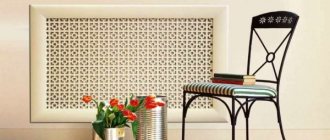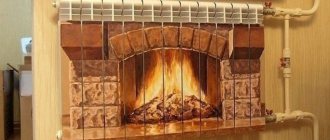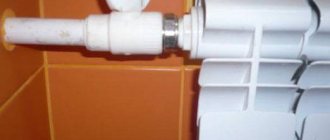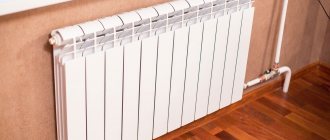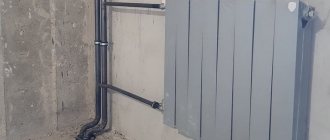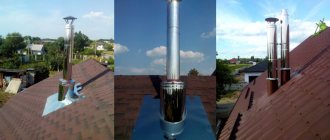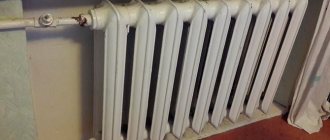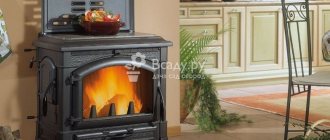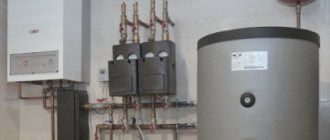Making a screen for a heating battery with your own hands
A do-it-yourself battery screen is mainly made from chipboard or MDF sheets. For the front panel, you should choose a metal mesh of any configuration. Also for installation you will need sheet metal to create a reflective element, fasteners in the form of construction staples and screws, wood glue and nails.
Before making a screen for a heating radiator, you need to take measurements
At the first stage, the dimensions of the radiator are measured. 10 cm is added to the resulting width value, and 5 cm to the height. These data are parameters for the future front panel of the screen. To obtain the width of the side parts made of MDF, it is necessary to add 2.5 cm to the depth of the radiator, and the length of the products will be equal to the height of the front panel. The dimensions of the top of the screen should be 1-2 cm larger than the dimensions of the side panels.
Based on the data obtained, rectangular products are cut out of MDF or chipboard. At the points of contact of the parts, an angle of 90 degrees is formed. Holes for pipes should be provided in the side faces. The front part in the form of a metal mesh is decorated with chipboard edges along the entire perimeter of the structure on the inner sides of the front corners.
You can make decorative grilles yourself by choosing the material and color that matches the curtains and wallpaper.
The next step is the assembly of the structure. A reflective screen is installed at the rear wall, the dimensions of which correspond to the dimensions of the decorative screen. It serves to prevent heat loss and redirect the IR flux from the battery into the room. All frame elements are fastened using special glue.
The decorative screen can be attached to the wall using anchor collets or attached to a radiator. For the second option, special legs should be provided at the bottom of the structure, which are attached using construction corners. This method not only creates a mobile structure that can be moved away when cleaning, but also allows you to adjust the height of the screen relative to the radiator.
It is quite possible to make a screen for a radiator that not only does not worsen heating, but also improves it yourself.
Thanks to a wide range of decorative grilles for heating radiators, you can choose the most suitable option, which will not only be an ideal addition to the interior, but will also decorate the radiator and provide reliable protection against possible injuries. Also, when choosing a product, you should be guided not only by aesthetic considerations, but also give preference to a design that should not impair the heating characteristics of the device.
What to pay attention to
When purchasing a product made from any material, you should pay attention to certain points in order to decide which heating radiators to install in your apartment. It will be easier with panel radiators, since their markings will already tell you about the product
In addition to the type, each manufacturer can display information about dimensional parameters. The number of panels will affect the overall thickness. So three panels will create a thickness of 15-18 cm, and one - only 6. It is not always better to take two-panel radiators instead of one panel. The fact is that the rear part of the former has a heat transfer power of about 60-70 percent of the front part. The type of connection may differ: from the side or from the bottom. In addition, the repair process varies somewhat.
When purchasing aluminum or bimetallic radiators, attention is focused on certain points, which include:
Working pressure in the heating system. For high-rise apartments from 16 floors only bimetallic radiators are suitable. Weight and structure of each section. The larger it is, the higher the quality and reliability. The likelihood of failure due to water hammer is minimized. In addition, such walls can provide higher heat transfer. Buying a lightweight product will not bring the desired results. When reducing thickness and weight, the manufacturer also reduces these parameters.
Coolant. Its quality may not always allow the use of, for example, aluminum radiators. All data must be checked with the product data sheet before choosing an aluminum heating radiator for an apartment. The acidity of the coolant has a negative effect on the internal condition of the walls, which leads to damage and the need to replace sections. Thread. The end part of threaded connections should not be filled with paint.
Otherwise, you should immediately pay attention to other products. The quality of the connections will depend on the purity. Painting
Particular attention is paid to the appearance of each heating system product. It is better to generally take out their packaging when purchasing and carefully inspect it. Any sagging, roughness of the paint, or burrs indicate poor quality work during production. A significant layer of paint that can be felt will also reduce the level of heat transfer. The warmest heating radiators for an apartment should be painted with a thin layer. Vertical channel. It can be wide or narrow, thick or thin. It is better to pay attention to thick and wide ones, which will additionally be combined with improved heat transfer properties. Documentation. If you are already purchasing a new heating system, the radiators should be from leading manufacturers. At the time of purchase, it is a good idea to ask for certificates of conformity and test documents. If the company's reputation is needed and he wants to preserve it, all this will be available. At the same time, not only the conditions of warranty service will differ, but also the places to which contact occurs in the event of a breakdown. Not every city will have service.
By paying attention to all these subtleties of purchasing a specific radiator option for a heating system, we can conclude that there are truly high-quality products, depending on the specific conditions of use. If you follow all the little details and nuances, including during installation, the batteries can last for a long period
You won’t have to think later about how to choose the right heating batteries for your apartment.
The article was written for the site https://sdelalremont.ru.
Video:
Video:
Video:
Principles of thermal engineering and masking of batteries
- Heating of the room is carried out through a combination or separate use of two techniques: convection and infrared radiation.
- Convective heat exchange ensures uniform heating of the air, and infrared radiation transfers heat to surrounding objects.
- Any method aimed at closing the radiators beautifully leads to losses in heating power. For example, a glass screen with artistic painting completely solves the problem of decorating heating appliances, but the temperature in the house will immediately drop. The reason is that glass almost completely neutralizes infrared radiation.
The more reliably the heat exchanger is disguised, the greater the heat loss will be. This fully applies to blind reflectors, which prevent the spread of infrared radiation and convection.
The picture is the same with blank panels covering the top of the batteries - they completely block the path of warm air, that is, the principle of convection does not work. Hence the conclusion, which is also the answer to the question of how to cover heating radiators in an apartment - the cover should have more holes, so heat loss will be minimal.
Additional requirements
Screens also play the role of protection, because the temperature of the coolant is quite high. This is especially true for centralized heating systems, where values can reach +100°C. The use of protective grilles is justified primarily in children's rooms.
Simple screen models are inexpensive, so purchasing them is not a problem. Installation also won’t take much time, especially since almost everyone has a workshop in their garage with a minimum of tools. However, certain requirements should be taken into account when choosing and installing:
It is necessary to ensure the accessibility of communications and heating devices, which is important during operation and repair. Plumbers believe that gratings should not be fixed; attached screens are best. High-quality screens do not become an obstacle to the passage of heat; on the contrary, they only contribute to the dissipation of heat flow. Products should not contain toxic components that can be released under high temperatures. Good products are not subject to deformation even with strong heating. Wood products are considered the best choice when purchasing gratings
If you have not yet decided how to hide the battery under the window, then this product is perfect
Wood products are considered the best choice when purchasing gratings. If you haven’t yet decided how to hide the battery under the window, then this product is perfect.
Plastic screens, especially from lesser-known manufacturers, may contain harmful toxic elements. The issue of authority is not an issue for them, so the use of low-quality components in the pursuit of excess profits is not ruled out.
MDF heating radiator grilles
In stores you can find a wide variety of shaped MDF grilles. It is possible to choose the appropriate pattern and hole size. The MDF panel is inserted into a wooden frame. If the radiator is located in a niche, an MDF grille will also be a good solution. You can make loops on one of its sides, and fasteners on the opposite side. This will make it easier to access the radiator.
You can buy an MDF screen in the form of a box. Such products are fixed to the wall and floor.
Installation of a decorative MDF grille on video:
Application nuances
When choosing thermal insulation, it is worth remembering that not everyone can reflect heat. In order for the indicator to be maximum, the foil must be thick enough. Most often, the insulation, its basis, is extruded polyethylene with a thick aluminum layer that retains maximum thermal energy. These include insulation materials Teplofol, Penofol, Alufol, and others.
Teplofol
Sheathing that can reflect is available in the form of mats, rolls, and pipe cylinders. If it is manufactured using testing technology, the thermal resistance characteristics must be indicated in the accompanying documents. If you foil the material, its range of applications will expand indefinitely. It's ideal for
For interior work, metallized polyethylene material, which is capable of reflecting heat, is ideal. When installing, you will need to leave a distance between the sheathing and the wall for ventilation. This will preserve the material and prevent moisture accumulation and mold growth. If this is external thermal insulation, you should choose mineral wool or polyethylene with metal
When laying, it is important that the material is joined, the cracks are taped with special tape. When the ceiling is insulated, mineral wool is used, a layer of air between it and the finish
To create such a structure, a sheathing of wooden blocks is installed, and a metal profile is also used.
For heating networks and small-diameter water mains, insulation without an air gap will be indispensable. If the pipe is large in diameter, a cushion between it and the casing is required; an exception to the rule is foiled mineral wool. When pipeline insulation is made of polyethylene, it is desirable that it be foil-coated on both sides. In order for heating radiators to operate at full capacity, they use a material that can effectively reflect heat. Cut the sheet to the size of the battery, place it between the wall and the heating device, the foil should be directed towards the room. Insulation is easy to install, but guarantees high efficiency of heaters, batteries, air heaters, increasing it by 30-35%.
Types and characteristics
Window sill grilles for heating radiators are divided into several types according to material, color, size, and shape.
According to the material of manufacture
The choice of suitable material depends on the type of window sill. The list of the most popular options includes:
- plastic: easy to install, affordable, available in various colors, shapes and sizes;
- wooden: made from natural or pressed wood with treatment to protect it from moisture, ideal for private homes;
- aluminum: lightweight, treated with a special anti-rust agent;
- made of stainless steel: characterized by a high level of strength, used for countertops and installation of external grilles.
By color
The gratings are painted in the color of the glass unit so that the overall design looks harmonious. Standard options are presented in white, steel models are treated with gold or silver plating. Wooden models are varnished in a mustard, honey or brown shade.
By shape
A do-it-yourself or factory-made radiator grill has a rectangular shape as standard, but can also be square, round or triangular, depending on the width and size of the window sill. Some models are made in the form of a fine or large mesh, diamond-shaped, woven or with round holes.
To size
The throughput of the element depends on the size of the grille for a home radiator in the countertop. Standard options have dimensions of 80x10, 80x8, 60x10 and 50x10 cm; for window sills with non-standard widths, wider or narrower options are made, for example, 80x20 or 30x8 cm.
By design features
Depending on the design, the elements can be built-in or landing. According to their structure, they are divided into static, performing a decorative function, adjustable with air flow control, inertial, regulating the flow power automatically, as well as shut-off, equipped with a valve that releases air.
According to the location and method of installation
Grilles can be installed indoors and outdoors
When installing internally, pay attention to the position of the battery. If it is located under the window sill, the element is mounted closer to the window; when the radiator protrudes beyond the window sill, it is advisable to install it above the radiator
Boxes, grilles and screens for heating radiators
Closing the radiators of the heating system
The box completely blocks all flows and heating is ineffective. The exception is the manufacturing option in accordance with the requirements:
- the box does not have a bottom bar and hangs at a distance from the floor;
- in the upper part there are holes for air outlet;
- The area of the holes on the front panel is larger than the remaining body of material.
Such a box is easy to make with your own hands if you know how to work with metal. You can make a structure from plasterboard by taking fire-resistant sheets and treating them with a primer. The parts are made according to the size of the cast iron radiator:
- 2 side posts, at the same time legs on which the box rests, and other parts are hung;
- Front Panel;
- top panel.
Hanging screens are sold in the store. They are made of metal and reduce heating slightly. The heating radiator is closed and has an aesthetic appearance.
When placing the battery in a wall niche, it is convenient to make gratings with your own hands. The simplest option is narrow wooden slats. They are installed at a great distance from each other. The area of infrared radiation decreases slightly. The convection current circulates freely. The room is warm and the radiator is nicely camouflaged.
The frosted glass screen with a beautiful pattern looks stylish. It can imitate a fireplace and simply decorate a room with its design. The area of infrared radiation is completely closed and half of the heat flow is lost.
Attention! Do not use plastic to create the box and screen. When heated, it releases harmful substances and quickly breaks down.
Construction of the box
This plasterboard structure can be fixed to the floor or suspended with a gap above its surface. The first option is preferable - the frame has two planes for support, which makes it stiffer.
USEFUL INFORMATION: Accessories for suspended ceilings and plasterboard walls
When designing the box, it should be taken into account that for normal operation of the device, a gap of at least 10 cm is required between the radiator and the surface of the drywall.
- Using a level (preferably a laser) and a tape measure, markings are carried out. The boundary of the upper edge of the structure is drawn on the wall, and perpendiculars are lowered from it to the floor. Using a square, lines are laid to the depth of the box. By connecting them, you get a lower border on the floor. As a result, you get two rectangles - on the floor and on the wall.
- The guide profile is secured along the lines with dowel nails in increments of 15–20 cm.
- Protruding vertical posts are made from a profile, bending it at an angle of 90˚. First, the side shelves are cut on the parts using metal scissors and bent. The bend points can be fixed using “bugs” (small screws for metal), or it is better to use a cutter.
There is an opinion that fastening with a cutter is not strong enough. However, when using a professional tool, the connection is not only very reliable, but also has the advantage of having no protruding parts, which is inevitable when using “bugs”.
- The required number of horizontal jumpers is installed. The more there are, the more rigid the structure. For a drywall box, 1-2 for each of the planes, with the exception of the front one, is quite enough.
- Parts of a decorative grille or removable screen are attached to the frame.
It is necessary to create a strong structure; any vibrations of the frame after installation are unacceptable.
- At the final stage, strips of plasterboard are cut to actual dimensions and secured with self-tapping screws every 25 cm. Subsequently, the plasterboard is puttied, and the finishing is carried out in accordance with the overall interior of the room.
Built in furniture
This is a very original solution. Heating radiators can be disguised with furniture. A chest of drawers or a small closet would look great. Such furniture is often made to order. But if you have at least basic woodworking skills, you can easily complete this design yourself.
In this case, you can use any other material. It can be plasterboard, MDF, laminate, chipboard or plywood.
Many owners are happy to use plastic to make the frame. This is a simple, cheap material that can fit perfectly into the interior. But when planning plastic structures, it is necessary to take into account the following disadvantage of the material. When heated, some species are capable of releasing quite toxic fumes into the air.
Design options
Before covering the battery with plasterboard, you should analyze the specific placement of radiators and piping in the room. Depending on their location, you can choose one of two options for using drywall:
- A gypsum plasterboard box with a decorative grille covering the battery.
- A false wall that hides radiators and connections to them behind its surface.
Options demonstrating how to cover a battery with your own hands using drywall are presented in the photo below. Both methods have their advantages and disadvantages:
- The installation of the box has the advantage of having less material required. But such a design will not always fit organically into the interior of the room. In addition, you will have to build your own boxes for the pipes, which will further complicate the task. In addition, the presence of such protrusions will seriously interfere with the installation of suspended ceilings or laying laminate flooring.
- The construction of a decorative wall will require more material consumption, but will allow you to obtain a flat surface that can be easily finished in accordance with the overall design of the room. In most cases, such a structure is even easier to build than the box that covers the battery.
What are radiator grilles made of?
Almost any material is used to make a decorative screen for heating radiators; it is important that it covers the unsightly edges of outdated equipment and has sufficient perforation for good heat transfer
You can use elements made of metal, plates, glass or plastic, but if you want to really surprise your guests, you should pay attention to products made of bamboo or rattan. Their price is slightly higher than their popular analogues, but, in addition to their beautiful appearance, they have excellent thermal conductivity and durability
Wood and metal
Metal is one of the most popular materials; thin sheet steel is used to make the radiator. The service life of such products depends on the quality of the paint; preference should be given to powder enamel, it protects against corrosion and lasts longer on the surface. The advantages of the material include:
- durability;
- when heated, the metal is an additional source of heat in the presence of perforation;
- low cost.
You can make a screen from forged gratings - this unique product will decorate any interior. Under the openwork forging, the original material will be visible, so it is recommended to first cover the radiators with a thin perforated metal sheet.
Wooden elements are classified as premium materials. They make completely unique products that will suit any style of room. Even inexpensive rocks can be used to create interesting compositions; however, one should not forget about perforation, since closed equipment will transfer heat to neighbors.
Hand forging is a work of art
Screen for radiator made of plastic and glass
Plastic for radiators is a controversial material; it is important to use a heat-resistant compound for batteries that can withstand heating temperatures of up to 70°C. It's easy to care for and inexpensive
However, it is necessary to note the negative aspects of the material:
- low thermal conductivity;
- low strength of cheap materials;
- At elevated temperatures it releases toxic substances, so it cannot be installed in children's and living rooms.
Glass screens began to be made only a few years ago. The thermal conductivity of the material is also low, but they have a beautiful appearance and fit perfectly into any interior. For batteries, only durable tempered glass is used; for decoration, the surface can be matted or an interesting pattern can be applied.
Glass screens can be made in different designs
Heating radiator box made of MDF and HDF
Decorative screens made of MDF and HDF− are made using natural components; natural lignin acts as a binder, so they are absolutely safe. HDF differs from MDF only in the production conditions: it is pressed under high pressure, resulting in a thin material with a more uniform and dense structure. HDF screens are better than wooden ones, since the material is thinner and the presence of perforations conducts heat well. It is from this fabric that beautiful openwork lattices are obtained. There are a number of advantages of using MDF and HDF:
- easy care;
- a wide variety of patterns and shades, you can choose for any room design;
- simple processing, does not require additional coloring;
- budget cost.
MDF lattice can be selected to suit any interior
How to choose radiator grilles
- If natural materials predominate in the interior decor, MDF and solid wood grilles will harmoniously combine with them.
- For a room decorated in a modern style with a radiator, choose glass or metal decor.
- If the room is dominated by interior textiles, it can also be used to sew beautiful covers.
- Heating radiators located inside plasterboard walls or in niches can be covered with screens in the form of gratings.
- Overhead casings are suitable for standard batteries.
If you are in doubt about your choice, contact our managers. By contacting us for material, you can take advantage of the following opportunities:
- Exclusive decoration of MDF products, made using laser cutting technology. We produce models with logos, emblems, monograms of any complexity.
- Painting of metal boxes in RAL shades, gold and chrome colors.
- Applying images to products using UV printing technology.
